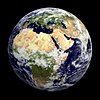TOI-715 b
| TOI-715 b | ||
|---|---|---|
| 星座 | とびうお座[注 1] | |
| 分類 | 太陽系外惑星 | |
| 発見 | ||
| 発見日 | 2023年5月10日[1] | |
| 発見者 | TESS[1] Dransfieldら[1] | |
| 発見方法 | トランジット法[1] | |
| 位置 元期:J2000.0[2] | ||
| 赤経 (RA, α) | 07h 35m 24.2565907060s[2] | |
| 赤緯 (Dec, δ) | −73° 34′ 38.826696668″[2] | |
| 固有運動 (μ) | 赤経: 82.634 ミリ秒/年[2] 赤緯: 9.987 ミリ秒/年[2] | |
| 年周視差 (π) | 23.5534 ± 0.0472ミリ秒[2] (誤差0.2%) | |
| 距離 | 138.5 ± 0.3 光年[注 2] (42.46 ± 0.09 パーセク[注 2]) | |
| 軌道要素と性質 | ||
| 軌道長半径 (a) | 0.0830±0.0027 au[1] | |
| 公転周期 (P) | 19.288004+0.000027 −0.000024 日[1] | |
| 軌道傾斜角 (i) | 89.856°+0.018° −0.017°[1] | |
| TOI-715の惑星 | ||
| 物理的性質 | ||
| 半径 | 1.550±0.064 R⊕[1] | |
| 平衡温度 (Teq) | 234±12 K[1] | |
| 他のカタログでの名称 | ||
| UCAC4 083-012601 b, TIC 271971130 b, WISE J073524.45-733438.8 b, 2MASS J07352425-7334388 b, Gaia DR2 5262666416118954368[1] | ||
| ■Template (■ノート ■解説) ■Project | ||
TOI-715 bとは、スペクトル分類がM型の恒星であるTOI-715のハビタブルゾーン内を公転しているスーパーアースの太陽系外惑星である[3][4][5]。
主星のTOI-715は、地球からとびうお座[注 1]の方向に約42パーセク(140光年)離れた場所に存在しており、天の南極に非常に近い位置にある赤色矮星である[1]。この恒星は太陽より小さく、温度も低く、見かけの等級は16.7で肉眼で観測することは不可能であり、小型の望遠鏡でも観測が難しいほど暗い恒星である[7]。
TOI-715 bは地球の1.55倍の大きさを持ち、主星から0.083天文単位 (12,400,000 km) 離れている[1]。また、主星のハビタブルゾーン内を公転しており、平衡温度は234 K (−39 °C) である[1]。TOI-715 bは2023年にTESSによって発見され[8]、発見論文の著者によると、保守的なハビタブルゾーンで発見された最初のTESSによって発見された惑星である[1]。「保守的なハビタブルゾーン」の概念は、惑星が地球が太陽から受ける日射量の0.42~0.842倍に相当する日射量を受ける領域であるとして、2014年にKoparappuらによって定義された[9]。TOI-715 bの日射量は0.67+0.15
−0.20 S🜨であるため、保守的なハビタブルゾーン内に位置している[1]。
NASAは、将来的にはジェイムズ・ウェッブ宇宙望遠鏡(JWST)が水や大気の証拠を調査するためにTOI-715 bが観測される可能性があると述べた[10]。さらに、同じ惑星系に2番目の太陽系外惑星TIC 271971130.02が存在する可能性があり、この惑星候補もハビタブルゾーン内を公転しているとされている[10]。
| 地球 | TOI-715 b |
|---|---|

|

|
脚注
[編集]注釈
[編集]出典
[編集]- ^ a b c d e f g h i j k l m n o Dransfield, Georgina et al. (2023-10-28). “A 1.55 R⊕ habitable-zone planet hosted by TOI-715, an M4 star near the ecliptic South Pole”. Monthly Notices of the Royal Astronomical Society 527 (1): 35–52. arXiv:2305.06206. doi:10.1093/mnras/stad1439. ISSN 0035-8711. "[W]hile several 'habitable zone' planets discovered by TESS have been confirmed (e.g. Gilbert et al. 2020; Vach et al. 2022), none yet have fallen within the conservative habitable zone as described by Kopparapu et al. (2013)—until now."
- ^ a b c d e f “Results for TOI-715”. SIMBAD Astronomical Database. CDS. 2024年7月31日閲覧。
- ^ “TOI-715 b”. Exoplanet catalog. NASA. 2024年2月4日閲覧。
- ^ Ralls, Eric (February 4, 2024). “Super-Earth discovered in the "optimal" habitable zone of its star, TOI-715 b”. Earth.com. 5 February 2024閲覧。
- ^ “NASA discovers 'Super-Earth' 137 light-years away”. The Economic Times. (February 4, 2024)
- ^ Vallenari, A. et al. (2022). “Gaia Data Release 3. Summary of the content and survey properties”. Astronomy & Astrophysics. arXiv:2208.00211. doi:10.1051/0004-6361/202243940 Gaia DR3 record for this source at VizieR.
- ^ “★ TOI 715” (英語). Stellar Catalog. 2024年6月18日閲覧。
- ^ Nazzaro, Miranda (February 5, 2024). “NASA announces 'super-Earth,' exoplanet in 'habitable zone'”. The Hill
- ^ Gough, Evan (2024年2月2日). “A Super-Earth (and Possible Earth-Sized) Exoplanet Found in the Habitable Zone” (英語). Universe Today. 2024年6月18日閲覧。
- ^ a b Brennan, Pat (January 31, 2024). “Discovery Alert: A 'Super-Earth' in the Habitable Zone”. NASA News and Events. NASA. 6 February 2024閲覧。
参考文献
[編集]- Jain, Vrinda (February 5, 2024). “NASA discovers potentially habitable 'super-Earth' 137 Light-Years Away”. ヒンドゥスタン・タイムズ
- Sarnoff, Leah (February 5, 2024). “NASA announces new 'super-Earth': Exoplanet orbits in 'habitable zone,' is only 137 light-years away”. ABCニュース
- Schwenck, Lennart (February 6, 2024). “Auf der Suche nach Leben: Forscher entdecken Super-Erde in bewohnbarer Zone [In search for life, researchers find super-Earth in habitable zone]” (ドイツ語). ミュンヘナー・メルクーア (Munich)
- Messier, Ashlyn (February 7, 2024). “NASA announces potentially habitable 'super-Earth,' only 137 light-years away”. FOXニュース




